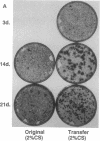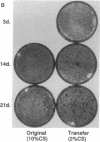Abstract
NIH 3T3 cells undergo morphological transformation in response to conditions of constrained growth, such as occur in low serum concentrations or at confluence. Transformation is expressed in a small fraction of the cells by the appearance of discrete foci of multiplying cells on a confluent monolayer of quiescent cells. We isolated and expanded cell populations from three dense and three light foci. Cells from each of these populations efficiently reproduced foci of the same morphotype when grown on a background of nontransformed NIH 3T3 cells. Using cultures derived from one of the dense foci (subline D/2), we found that the number of focus-forming units was stable and the cells remained tumorigenic when they were subjected to repeated thrice-weekly passage in 2% calf serum. However, equivalent passage in 10% calf serum eventually rendered the cells incapable of both focus production and tumor formation. The results show that the capacity to produce tumors as well as morphological transformation are produced as a response to physiological constraints of growth and/or metabolism in the absence of carcinogens and that both properties can be reversed by lifting the constraints. This behavior is typical of an adaptational response and, taken together with other supporting evidence, shows that tumorigenesis does not require conventional genetic alteration.
Full text
PDF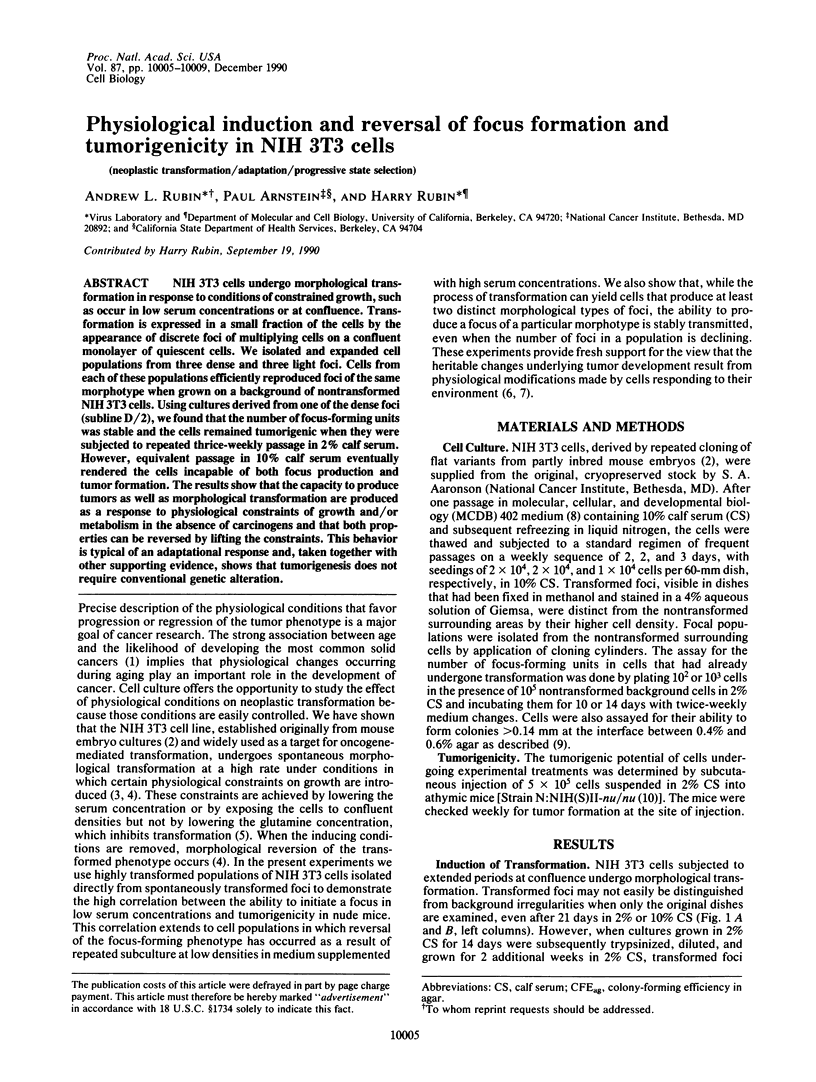
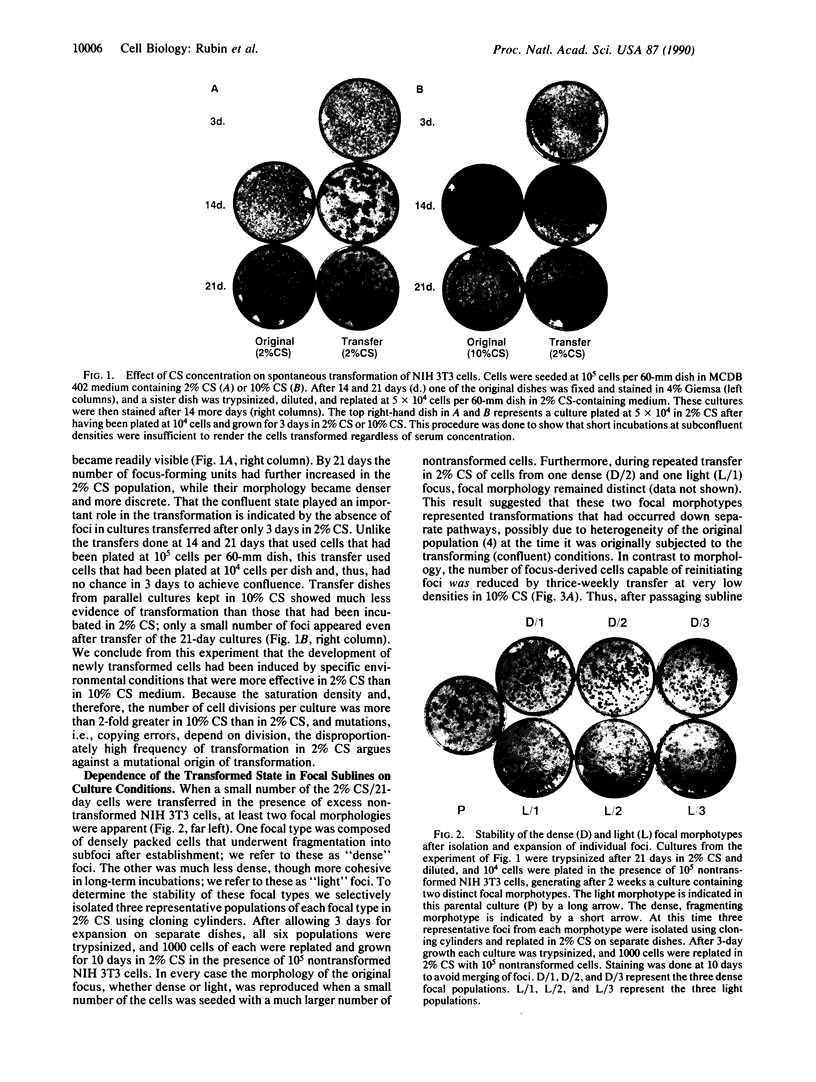
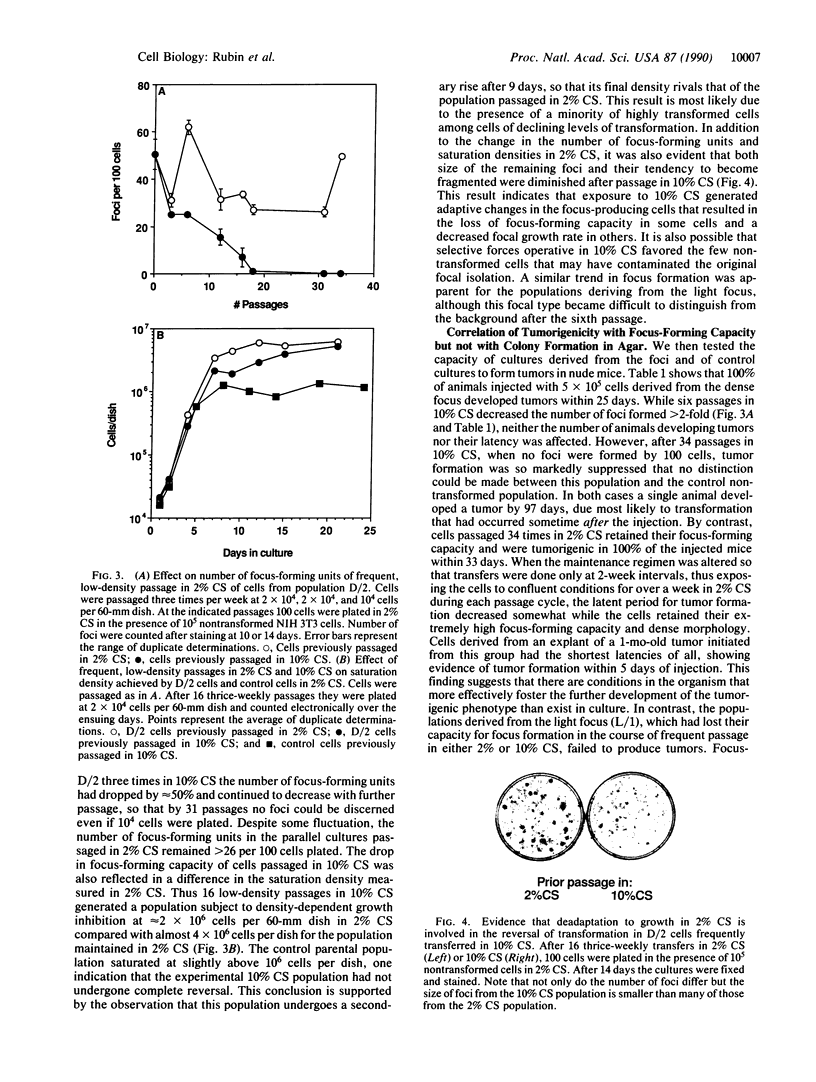
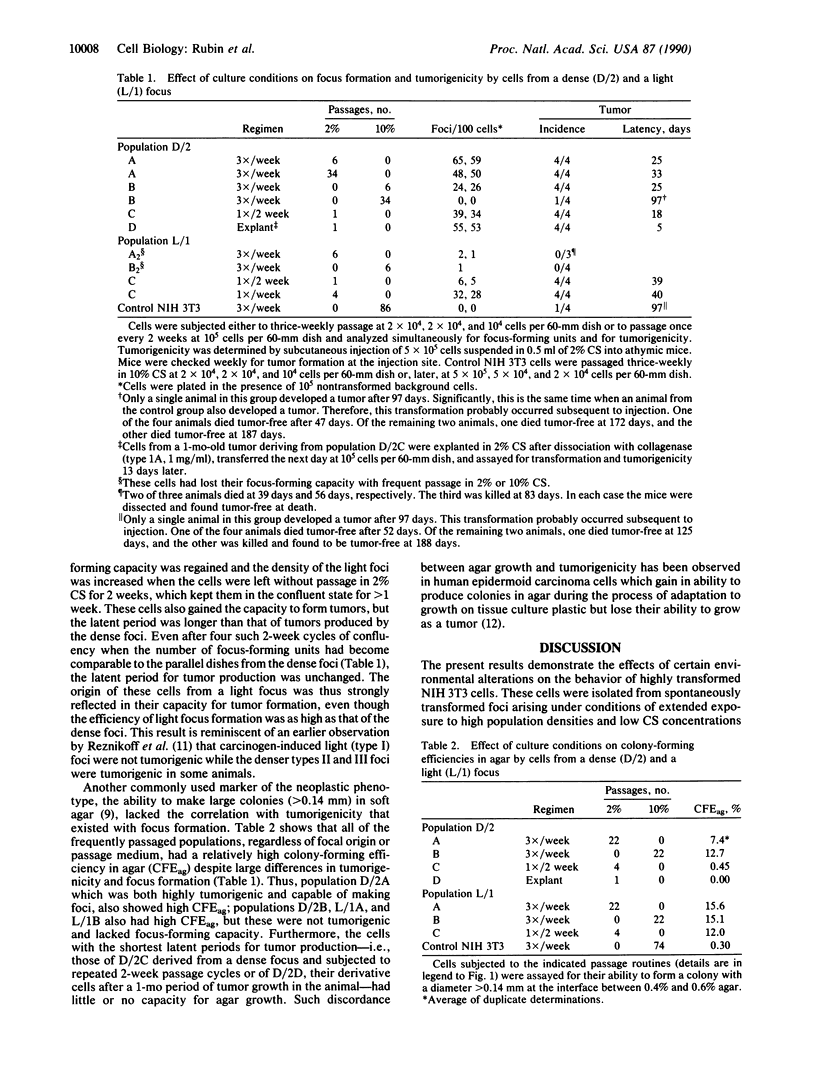
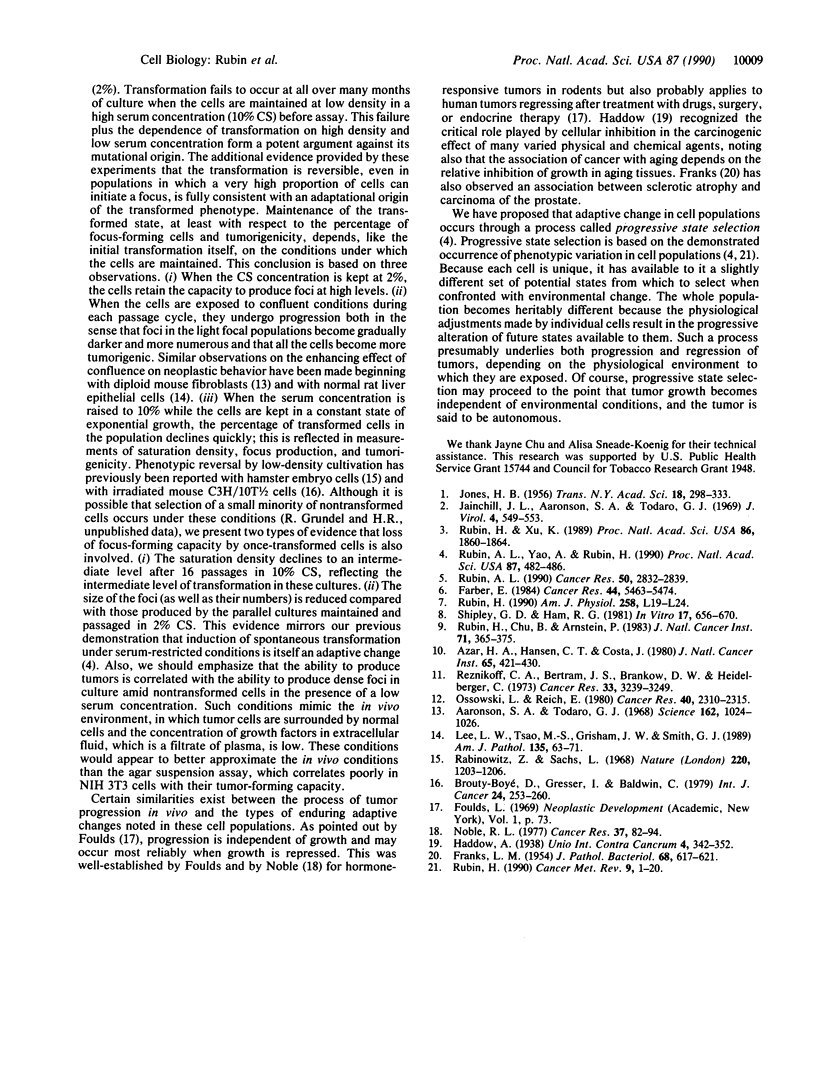
Images in this article
Selected References
These references are in PubMed. This may not be the complete list of references from this article.
- Aaronson S. A., Todaro G. J. Basis for the acquisition of malignant potential by mouse cells cultivated in vitro. Science. 1968 Nov 29;162(3857):1024–1026. doi: 10.1126/science.162.3857.1024. [DOI] [PubMed] [Google Scholar]
- Azar H. A., Hansen C. T., Costa J. N:NIH(S)-nu/nu mice with combined immunodeficiency: a new model for human tumor heterotransplantation. J Natl Cancer Inst. 1980 Aug;65(2):421–430. [PubMed] [Google Scholar]
- Brouty-Boyé D., Gresser I., Baldwin C. Reversion of the transformed phenotype to the parental phenotype by subcultivation of X-ray-transformed C3H/10T1/2 cells at low cell density. Int J Cancer. 1979 Aug;24(2):253–260. doi: 10.1002/ijc.2910240218. [DOI] [PubMed] [Google Scholar]
- FRANKS L. M. Atrophy and hyperplasia in the prostate proper. J Pathol Bacteriol. 1954 Oct;68(2):617–621. doi: 10.1002/path.1700680234. [DOI] [PubMed] [Google Scholar]
- Farber E. Cellular biochemistry of the stepwise development of cancer with chemicals: G. H. A. Clowes memorial lecture. Cancer Res. 1984 Dec;44(12 Pt 1):5463–5474. [PubMed] [Google Scholar]
- JONES H. B. Demographic consideration of the cancer problem. Trans N Y Acad Sci. 1956 Feb;18(4):298–333. doi: 10.1111/j.2164-0947.1956.tb00453.x. [DOI] [PubMed] [Google Scholar]
- Jainchill J. L., Aaronson S. A., Todaro G. J. Murine sarcoma and leukemia viruses: assay using clonal lines of contact-inhibited mouse cells. J Virol. 1969 Nov;4(5):549–553. doi: 10.1128/jvi.4.5.549-553.1969. [DOI] [PMC free article] [PubMed] [Google Scholar]
- Lee L. W., Tsao M. S., Grisham J. W., Smith G. J. Emergence of neoplastic transformants spontaneously or after exposure to N-methyl-N'-nitro-N-nitrosoguanidine in populations of rat liver epithelial cells cultured under selective and nonselective conditions. Am J Pathol. 1989 Jul;135(1):63–71. [PMC free article] [PubMed] [Google Scholar]
- Noble R. L. Hormonal control of growth and progression in tumors of Nb rats and a theory of action. Cancer Res. 1977 Jan;37(1):82–94. [PubMed] [Google Scholar]
- Ossowski L., Reich E. Loss of malignancy during serial passage of human carcinoma in culture and discordance between malignancy and transformation parameters. Cancer Res. 1980 Jul;40(7):2310–2315. [PubMed] [Google Scholar]
- Rabinowitz Z., Sachs L. Reversion of properties in cells transformed by polyoma virus. Nature. 1968 Dec 21;220(5173):1203–1206. doi: 10.1038/2201203a0. [DOI] [PubMed] [Google Scholar]
- Reznikoff C. A., Bertram J. S., Brankow D. W., Heidelberger C. Quantitative and qualitative studies of chemical transformation of cloned C3H mouse embryo cells sensitive to postconfluence inhibition of cell division. Cancer Res. 1973 Dec;33(12):3239–3249. [PubMed] [Google Scholar]
- Rubin A. L. Suppression of transformation by and growth adaptation to low concentrations of glutamine in NIH-3T3 cells. Cancer Res. 1990 May 1;50(9):2832–2839. [PubMed] [Google Scholar]
- Rubin A. L., Yao A., Rubin H. Relation of spontaneous transformation in cell culture to adaptive growth and clonal heterogeneity. Proc Natl Acad Sci U S A. 1990 Jan;87(1):482–486. doi: 10.1073/pnas.87.1.482. [DOI] [PMC free article] [PubMed] [Google Scholar]
- Rubin H., Chu B. M., Arnstein P. Heritable variations in growth potential and morphology within a clone of Balb/3T3 cells and their relation to tumor formation. J Natl Cancer Inst. 1983 Aug;71(2):365–375. [PubMed] [Google Scholar]
- Rubin H. On the nature of enduring modifications induced in cells and organisms. Am J Physiol. 1990 Feb;258(2 Pt 1):L19–L24. doi: 10.1152/ajplung.1990.258.2.L19. [DOI] [PubMed] [Google Scholar]
- Rubin H., Xu K. Evidence for the progressive and adaptive nature of spontaneous transformation in the NIH 3T3 cell line. Proc Natl Acad Sci U S A. 1989 Mar;86(6):1860–1864. doi: 10.1073/pnas.86.6.1860. [DOI] [PMC free article] [PubMed] [Google Scholar]
- Shipley G. D., Ham R. G. Improved medium and culture conditions for clonal growth with minimal serum protein and for enhanced serum-free survival of Swiss 3T3 cells. In Vitro. 1981 Aug;17(8):656–670. doi: 10.1007/BF02628401. [DOI] [PubMed] [Google Scholar]



